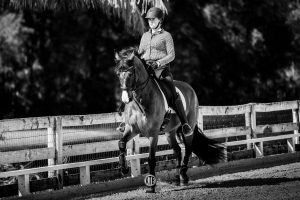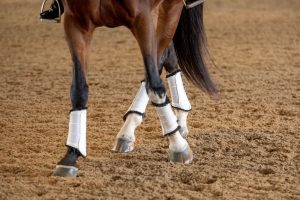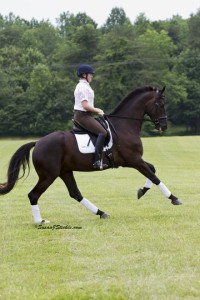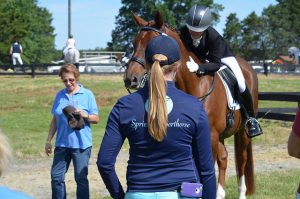Getting By With A Little Help From My Friends
 Elvis is really cool, guys. He’s keen but relatively unemotional. He’s athletic, but he’s also efficient. His default answer is yes. There’s a heck of a lot to like.
Elvis is really cool, guys. He’s keen but relatively unemotional. He’s athletic, but he’s also efficient. His default answer is yes. There’s a heck of a lot to like.
He also was weird about the whip when he came to me, and he had a bit of a misunderstanding about what piaffe was all about, so it took some time to get him confident enough to accept a new approach. And then, about a year ago, he started letting us in, and over the course of the summer it started becoming a re-creatable phenomenon, first in hand, then from the tack. And then we hit a bit of a plateau, which isn’t unusual. And a year in the life of a horse learning to piaffe is such a tiny amount of time.
But I just felt stuck and lost. Ali Brock, my amazing coach, kept telling me that I was on the path, and that it was improving, but I really wanted someone else to feel what I was feeling from the tack, and Ali is pregnant and not riding right now.
Read the rest at The Chronicle of the Horse!
 For those who’ve never been, south Florida is… gross. It’s warm and soggy all the time, there’s a lot of microbes in the soil, and land is a gajillion dollars so turnout is small and sandy. It’s a recipe for some challenges with my horses’ skin, and leg skin in general, being close to the ground, and often wearing boots while sweating. But ten winters down here has given me some tools. Here are my favorites right now.
For those who’ve never been, south Florida is… gross. It’s warm and soggy all the time, there’s a lot of microbes in the soil, and land is a gajillion dollars so turnout is small and sandy. It’s a recipe for some challenges with my horses’ skin, and leg skin in general, being close to the ground, and often wearing boots while sweating. But ten winters down here has given me some tools. Here are my favorites right now. A few neat training metaphors I’ve either made up myself or shamelessly stolen from others. If I could draw, I’d draw these, but I can’t, so instead you get my words. Enjoy.
A few neat training metaphors I’ve either made up myself or shamelessly stolen from others. If I could draw, I’d draw these, but I can’t, so instead you get my words. Enjoy. There’s a kid I see pop up on my social media from time to time. She starts young horses and then sells them, which is why I see her posts. The horses are always well groomed and ridden and presented tactfully. The videos are well put together. The text on her ads is articulate and correct. And that’s all well and good, but the part that stands out is that this kid can RIDE. She’s clearly bold. She sits. She puts her leg on. She’s the kind of rider I want a million of for my own barn, and she’s young and driven and, according to her website, hungry for excellence at the international level one day.
There’s a kid I see pop up on my social media from time to time. She starts young horses and then sells them, which is why I see her posts. The horses are always well groomed and ridden and presented tactfully. The videos are well put together. The text on her ads is articulate and correct. And that’s all well and good, but the part that stands out is that this kid can RIDE. She’s clearly bold. She sits. She puts her leg on. She’s the kind of rider I want a million of for my own barn, and she’s young and driven and, according to her website, hungry for excellence at the international level one day.